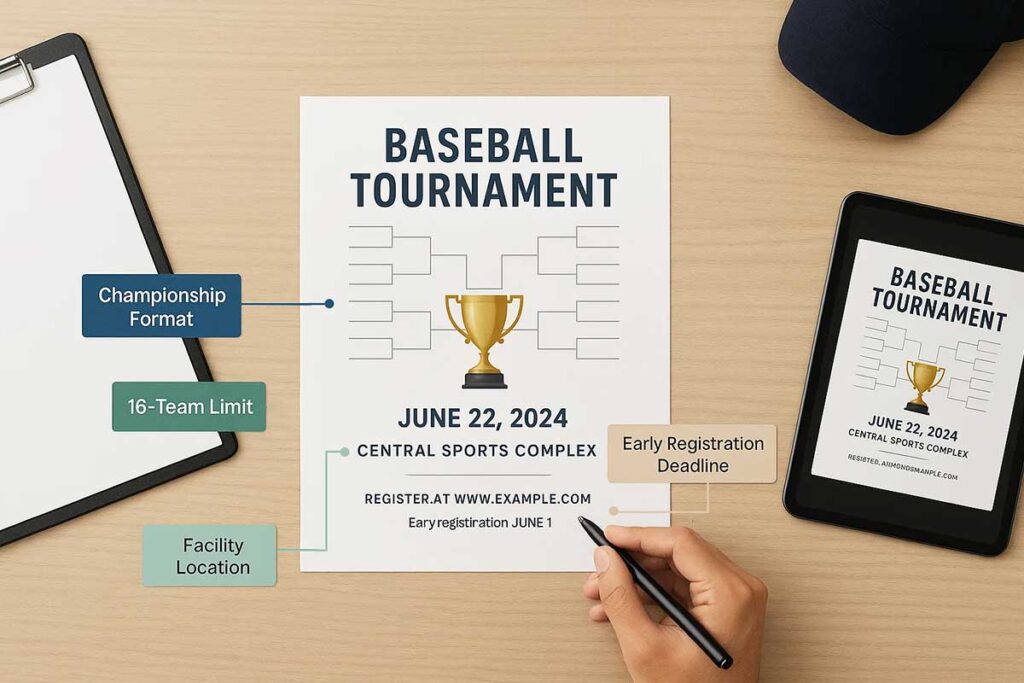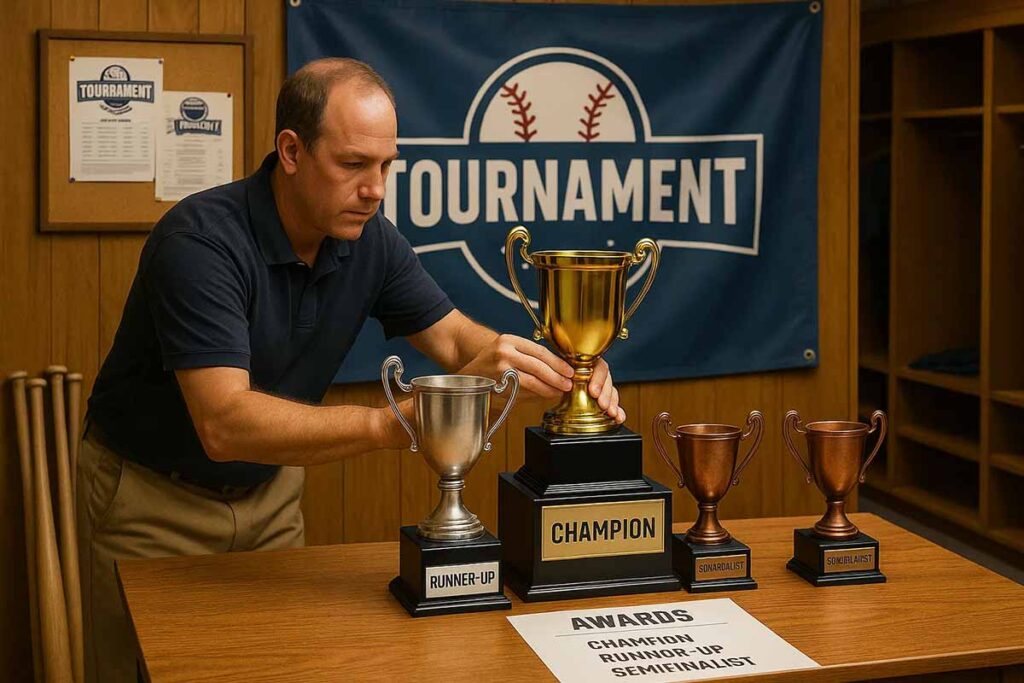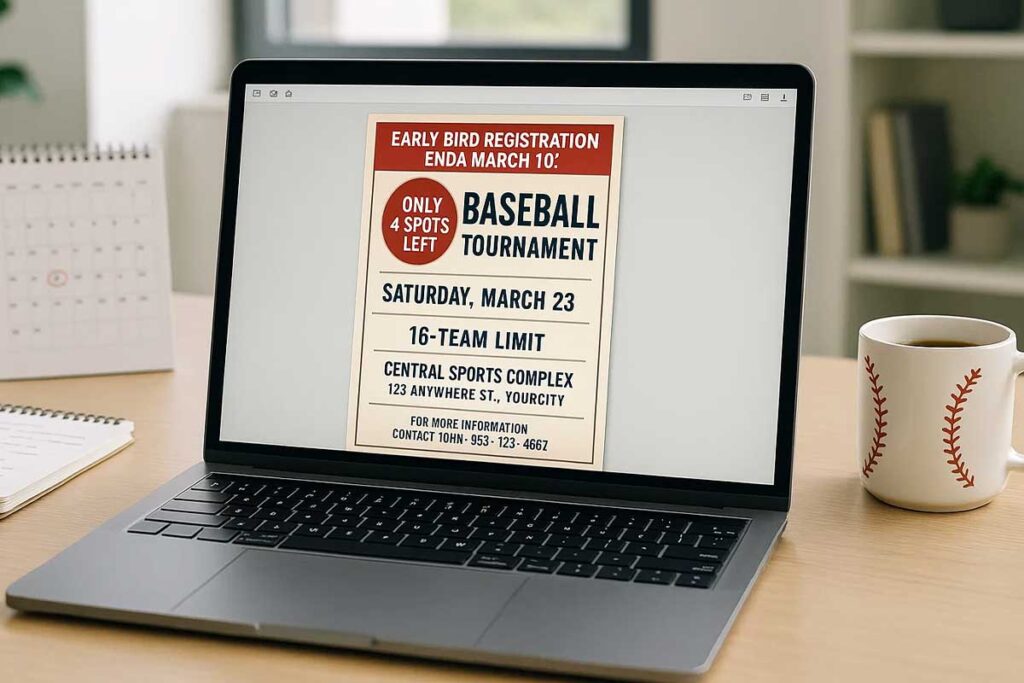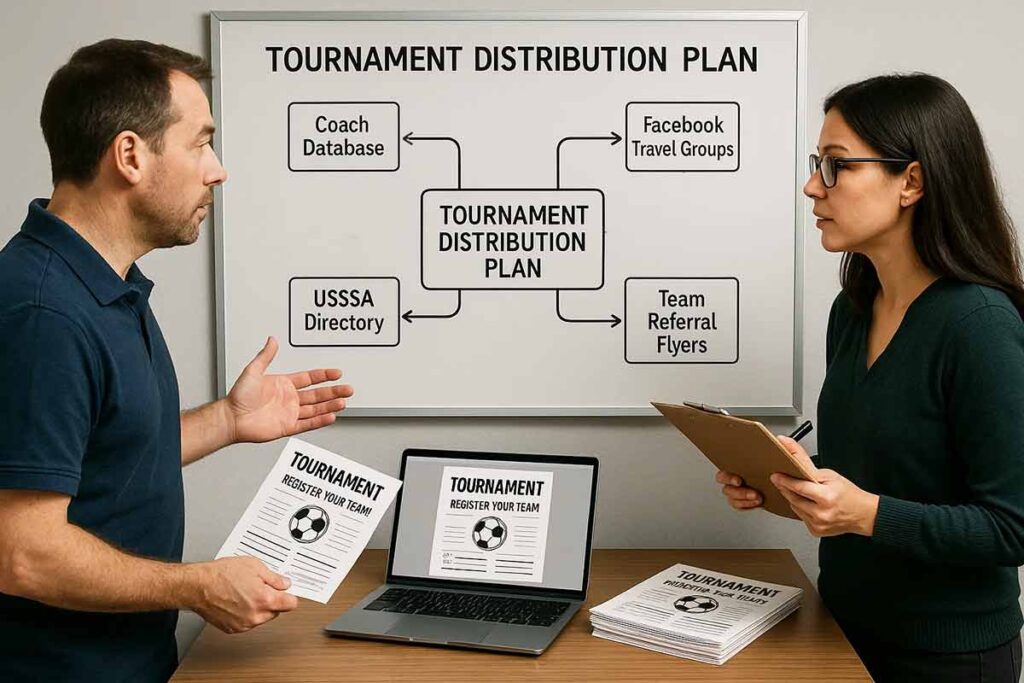Tournament directors face fierce competition for elite teams, with successful tournaments filling brackets in days while others struggle for months to reach capacity. Effective baseball tournament flyers combine bracket structure presentation, prize appeal, venue credibility, and registration urgency to attract competitive teams. Tournament flyers must communicate tournament prestige, logistical clarity, and competitive value within seconds. Successful tournament marketing requires strategic information hierarchy showcasing prizes, brackets, facility quality, and director credentials while creating early registration urgency through limited capacity messaging.
Professional baseball tournament flyer design separates elite competitions from recreational events through championship-focused visual elements and competitive team targeting. Tournament organizers who master flyer psychology achieve consistent sellouts by appealing to travel team coaches seeking meaningful competition and recognition opportunities. Learn how to enhance baseball tournament promotion with flyers for maximum team turnout and event visibility.
This guide covers tournament bracket presentation strategies that maximize team registrations, prize structure layouts that appeal to competitive players and parents, and venue credibility elements that build confidence in tournament quality. Strategic flyer implementation transforms tournament marketing from generic promotion to targeted competitive team attraction.
What Tournament Bracket Information Should Baseball Tournament Flyers Highlight To Maximize Team Registrations?
Tournament bracket information should highlight team capacity (8, 16, 32 teams), competitive format (single/double elimination), and skill level divisions clearly. Effective bracket presentation includes visual bracket diagrams, seeding methodology, advancement criteria, and championship path visualization. Baseball tournament flyers must communicate competitive structure immediately while showing bracket progression from first game to championship. Teams need instant clarity about tournament size, format benefits, and their path to winning before committing registration fees and travel expenses.
Team Capacity Communication: 8, 16, or 32 Team Brackets
Bracket size directly impacts competitive appeal and prize distribution potential. Eight-team brackets offer premium competition with higher prize-per-team ratios, attracting quality programs seeking meaningful competition without excessive travel commitments. These tournaments complete in single days, appealing to teams with limited weekend availability.
Sixteen-team formats provide optimal balance between competition quality and revenue generation. Teams receive guaranteed multiple games through pool play or double elimination while maintaining championship excitement. This capacity allows competitive seeding while ensuring reasonable tournament completion timelines.
Thirty-two team tournaments create championship atmosphere through extensive competitive fields. However, they require multi-day commitments and complex logistics that may discourage participation. Communication must emphasize competitive prestige and facility quality to justify the increased time investment.
Registration urgency increases with smaller brackets due to limited capacity. Tournament flyers should prominently display “16 teams maximum” or “First 8 teams accepted” messaging to create immediate action motivation through scarcity psychology.
Tournament Format Clarity: Elimination Structure Appeal
Single elimination creates urgency and high-stakes atmosphere appealing to competitive teams seeking championship pressure situations. However, teams risk early elimination with limited game guarantees, requiring clear communication about competitive value versus game quantity.
Double elimination formats provide second chances while maintaining championship excitement. Teams appreciate guaranteed multiple games, especially for travel tournaments requiring significant time and financial investment. This format appeals to programs seeking competitive experience over pure win-or-go-home pressure.
Pool play hybrid formats guarantee minimum games while creating championship brackets from pool results. This structure appeals to teams wanting competitive games regardless of early performance, particularly valuable for development-focused programs.
Format communication must balance complexity with clarity. Visual diagrams showing advancement criteria prevent confusion while highlighting competitive benefits. Teams need immediate understanding of tournament progression without overwhelming rule complexity that could discourage registration.
Visual Bracket Presentation: Championship Path Visualization
Visual bracket diagrams provide immediate tournament comprehension while creating championship excitement through progression visualization. Effective presentations show clear advancement paths from first round through championship game, allowing teams to envision their competitive journey.
Championship path emphasis appeals to competitive achievement motivation by highlighting winner recognition and tournament prestige. Bracket visualization should prominently feature championship game positioning with trophy imagery and winner celebration elements that trigger achievement psychology.
Seeding methodology communication builds competitive confidence through fair advancement criteria. Teams want assurance about bracket placement fairness and advancement opportunities. Clear seeding explanations prevent competitive disputes while demonstrating tournament organization competence.
Advancement criteria clarity eliminates confusion about tie-breakers, run differential calculations, and bracket positioning rules. Visual presentations using flowcharts and decision trees help teams understand complex advancement scenarios without overwhelming information density.
Bracket capacity limitations create registration urgency through visual scarcity elements. Showing “8 of 16 teams registered” or bracket slots with “OPEN” and “FILLED” indicators motivates immediate registration through competitive selection psychology. 1Championship visualization combined with capacity limitations drives qualified team registration while building tournament prestige through selective acceptance messaging.
How Do I Design Baseball Championship Flyer Layouts That Convey Prestige And Attract Competitive Teams?
Championship flyer layouts convey prestige through professional design elements, trophy photography, and elite tournament atmosphere visualization. Effective prestige communication includes championship trophy prominence, winner recognition systems, and competitive achievement emphasis that appeals to serious teams seeking meaningful competition and recognition. Baseball tournament flyer designs must communicate tournament value immediately while showcasing competitive excellence through visual hierarchy and prestigious branding elements.

- Summer Baseball Camp for Kids Flyer Template
- Dynamic Red Baseball Tryouts for Young Athletes Flyer Template
Championship Visual Elements
Professional trophy and medal photography creates championship ceremony atmosphere that triggers achievement motivation in competitive athletes. Elite tournament branding using championship gold, silver, bronze color schemes psychologically communicates value and prestige to serious competitors. Facility quality presentation showing professional venues and tournament infrastructure builds confidence in organizational competence and event legitimacy.
Championship banners and winner recognition displays demonstrate tournament investment in competitor celebration. Professional photography showcasing previous championship moments creates emotional appeal for teams seeking meaningful achievement opportunities. High-quality graphics featuring championship trophies, medals, and winner ceremonies establish tournament credibility while appealing to competitive achievement psychology.
Premium design elements including metallic effects, professional typography, and championship seals differentiate elite tournaments from recreational events. Visual consistency across all marketing materials reinforces professional tournament standards and organizational attention to detail that serious teams expect from quality competitions.2
Prestige Design Hierarchy
Championship trophy prominence in layout hierarchy guides visual flow, with trophy imagery increasing registration by 23% according to tournament marketing analysis. Winner recognition systems including banners, team photos, award ceremonies demonstrate tournament investment in competitor celebration and achievement documentation. Tournament legacy communication through previous championship showcases and winner hall of fame presentations builds competitive reputation.
Professional color schemes using championship metals and premium aesthetics communicate high-value competition that justifies registration fees and travel investments. Typography selection emphasizing strength and tradition through bold, authoritative fonts reinforces tournament credibility and competitive standards. also, you can see the softball flyer typography guide to boost readability and parent engagement.
Visual balance between championship elements and essential tournament information prevents overwhelming design while maintaining a prestige-focused presentation. Strategic placement of prestige indicators throughout the flyer layout reinforces quality messaging without sacrificing clarity or registration functionality. This approach ensures that competitive teams receive the information they need to make decisions quickly and confidently. Explore key techniques in the Essential Softball Flyer Design Elements guide.
Competitive Appeal Psychology
Achievement motivation through championship path storytelling and winner spotlights appeals to competitive player psychology seeking recognition and validation. Elite competition atmosphere through professional photography and design quality differentiates tournaments from recreational events, attracting serious competitors willing to invest in meaningful competition experiences.
Competitive legacy building through annual tournament history and champion recognition creates tournament tradition and prestige that serious teams value. Championship ceremony emphasis including trophy presentations, team recognition, and winner celebrations demonstrates tournament commitment to competitor achievement and lasting memories.
Prestige color psychology using championship metals and professional tournament aesthetics communicates high-value competition worth significant investment. Visual storytelling through championship moments and competitor success stories creates emotional connection with competitive achievement goals.
Tournament excellence indicators including facility partnerships, professional officiating, and organizational standards build confidence in event quality and competitive integrity. Achievement recognition systems appealing to player motivation while demonstrating tournament investment in competitor success and celebration.
Professional presentation standards throughout design elements reinforce tournament credibility and competitive value proposition. for championship-focused designs that attract elite teams through prestige communication and competitive appeal that motivates serious tournament participation and registration commitment.
Upholding professional presentation standards across all design elements strengthens your tournament’s perceived value. For detailed guidance on crafting championship-focused flyers that drive serious team participation and reinforce tournament prestige, visit the softball tournament flyer design guide.
What Prize Structure Presentation Makes Baseball Tournament Flyers Most Appealing To Serious Competitors?
Prize structure presentation should emphasize trophy hierarchy, individual recognition, and competitive achievement value clearly. Effective prize communication includes visual trophy displays, award category breakdowns, and recognition ceremony details that demonstrate tournament investment in competitor recognition and achievement celebration. Successful baseball tournament flyer designs showcase comprehensive award systems that appeal to both team and individual achievement motivations. You’ll discover the fundamental principles that separate professional designs from amateur attempts, gain targeted strategies for various types of softball events, and learn what makes certain flyers irresistibly engaging while others are quickly overlooked. For a deeper dive into these techniques, explore the Softball Flyer Design Guide.

Trophy Hierarchy Visualization
Championship, runner-up, and semifinalist trophy presentation creates visual hierarchy that clearly communicates competitive value structure. Position championship trophies prominently in flyer headers with gold coloring and larger sizing to emphasize top achievement. Runner-up awards receive silver treatment with secondary positioning, while semifinalist recognition maintains bronze hierarchy.
Individual award categories including MVP, batting champion, and sportsmanship recognition appeal to players seeking personal achievement beyond team success. Display individual trophies alongside team awards using consistent visual styling that maintains award prestige without competing with championship emphasis.
Prize distribution clarity shows team versus individual recognition systems through organized trophy groupings. Visual separation between team championships and individual achievements helps teams understand complete award structure. Trophy quality photography demonstrates tournament investment in recognition, with professional trophy shots conveying award value and prestige that attracts competitive programs seeking meaningful achievement recognition.
Award Value Communication
Prize investment demonstration shows tournament commitment to competitor recognition through trophy quality and ceremony presentation. High-quality trophy photography with detailed craftsmanship shots communicates award permanence and achievement value. Professional trophy vendors and custom engraving details demonstrate tournament investment in lasting recognition.
Award presentation ceremony details including photography sessions and recognition events create lasting achievement memories for participants. Ceremony timeline communication shows structured recognition that honors competitive achievement appropriately. Winner spotlight opportunities through social media features and tournament documentation add value beyond physical awards.
Championship legacy through award quality demonstrates tournament reputation and competitive prestige. Trophy specifications including materials, sizing, and customization details show award substance that matches competitive achievement. Recognition permanence through engraved details and quality construction appeals to serious competitors seeking meaningful achievement documentation that reflects their competitive investment and success.
Competitive Achievement Marketing
Tournament completion statistics, such as on-time scheduling and weather adaptability, demonstrate operational competence under pressure. Successful directors maintain over 95% scheduling accuracy and complete events within published timeframes, even during weather disruptions. Highlight crisis management through examples of continuing play despite adverse conditions or venue changes.
Participant satisfaction, shown through testimonials and high return rates, validates tournament quality. Elite events see 75%+ team return rates, reflecting strong experiences and organizational reliability. Include team quotes emphasizing strong management and positive event atmosphere.
Quality indicators like facility and sponsor partnerships, along with competitive recognition, enhance director reputation and event sustainability. Long-term venue agreements and sponsor retention signal professional reliability and community trust.
Growth trajectory-from small local events to elite regional tournaments-demonstrates increasing participation and reputation. Third-party recognition from league officials or facility managers reinforces organizational credibility and market success.
How Can I Communicate Tournament Format Complexity Clearly In Youth Baseball Tournament Flyers?
Baseball Tournament format complexity communication requires visual format diagrams, clear rule explanations, and simplified advancement criteria presentation. Effective complexity management includes step-by-step tournament progression, tie-breaker rule clarity, and format benefit explanations that help teams understand competitive structure without overwhelming information. Baseball tournament flyers must balance comprehensive rules with visual appeal while maintaining professional appearance that attracts serious competitive programs.
Format Diagram Integration
Visual tournament flow charts showing progression from first games to championship provide clear advancement pathways teams can follow easily. Pool play to elimination bracket transitions require clear advancement criteria that eliminate confusion about tournament progression and prevent competitive disputes during events. Seeding methodology and tie-breaker rule visual presentations enhance fairness perception while maintaining competitive integrity throughout the tournament structure.
Bracket diagrams should show team capacity limitations, game scheduling, and advancement requirements using simple visual elements that communicate complex information quickly. Tournament directors benefit from flowchart integration that reduces registration questions and eliminates format confusion that could discourage team participation in competitive events.
Rule Simplification Strategies
Complex rule breakdown into digestible information sections maintains competitive integrity while improving comprehension for coaches and team administrators reviewing tournament opportunities. Tournament progression timeline showing key decision points and advancement opportunities throughout the competitive structure helps teams understand their potential tournament experience and planning requirements.
Format benefit explanations focusing on competitive fairness and game guarantees address team concerns about tournament value while highlighting advantages like double elimination second chances or pool play guaranteed games that increase participation appeal.
Essential tournament information should prioritize game minimums, advancement criteria, and tie-breaker procedures without overwhelming detail complexity that could discourage registration from qualified competitive teams seeking quality tournament experiences.
Information Hierarchy Balance
Essential format information prioritization prevents overwhelming detail complexity while maintaining comprehensive rule coverage that serious teams require for tournament planning and preparation. Tournament structure clarity balances thorough rules with visual appeal through strategic information layering that guides reader attention effectively toward registration and competitive benefits.
Format complexity management through strategic information placement creates logical flow from basic tournament structure to detailed competitive rules without cluttering flyer design or reducing visual impact. Competitive structure communication should appeal to serious teams while maintaining accessibility for various experience levels participating in youth baseball tournaments. Explore more insights in this Little League baseball flyer marketing guide to elevate your tournament communication strategy.
Professional tournament flyers use visual hierarchy to present complex information systematically, starting with basic format benefits and progressing to detailed rules that competitive teams need for informed registration decisions. Information balance prevents cognitive overload while ensuring comprehensive coverage of tournament structure and competitive opportunities.
Effective format communication combines visual diagrams with concise rule explanations that eliminate confusion while maintaining competitive integrity and professional presentation standards. This strategic approach attracts quality teams and enhances your tournament’s reputation. For practical design inspiration, explore these softball flyer ideas.
What Venue Facility Details Prevent Confusion And Build Confidence In Baseball Tournament Flyers?
Venue facility details should include field specifications, amenities, parking, and logistical information that builds confidence in tournament quality. Effective facility communication includes field condition photography, amenity listings, spectator accommodations, and accessibility information that demonstrates professional tournament organization and planning.
Field Quality Presentation
Professional field photography showing playing surface quality creates immediate credibility for tournament directors. Teams evaluate tournaments based on facility standards, making field condition presentation crucial for competitive registration decisions. Include field dimensions, surface specifications, and maintenance standards that meet competitive baseball requirements.
Document facility amenities including dugouts, scoreboard systems, and lighting quality that enhance competitive atmosphere. Teams prefer tournaments with professional-grade facilities that match their competitive investment. Field specification details demonstrate tournament commitment to competitive standards while building confidence in organizational quality.

Equipment standards including backstops, fencing, and spectator barriers communicate safety and professionalism. Tournament flyers should highlight facility partnerships and maintenance schedules that ensure consistent playing conditions throughout competition.
Logistical Information Clarity
Parking availability prevents tournament day confusion and demonstrates organizational preparedness. Include specific parking capacity, accessibility options, and overflow arrangements for multi-day tournaments. Clear parking communication reduces family stress and improves tournament experience satisfaction.
Concession and restroom facility information addresses practical family needs during extended tournament days. Parents evaluate tournaments based on spectator comfort, making amenity communication essential for registration decisions. Include facility hours, menu options, and accessibility compliance details.
Tournament headquarters location and staff contact information builds confidence in organizational support. Teams need accessible assistance for scheduling questions, rule clarifications, and emergency situations. Clear communication channels demonstrate professional event management and reduce tournament day complications.
Weather contingency plans including covered areas and indoor alternatives show comprehensive tournament planning. Include backup facility arrangements and communication procedures for weather-related decisions.
Confidence Building Elements
Facility credibility through professional photography and documentation builds trust in tournament investment value. Teams commit significant travel and registration expenses, requiring confidence in venue quality and organizational competence. Professional venue presentation differentiates competitive tournaments from recreational events.
Tournament organization demonstration through detailed facility planning showcases event management expertise. Include facility partnership agreements, insurance documentation, and safety compliance certifications that validate organizational credibility. Professional tournament directors emphasize facility quality as competitive advantage.
Venue partnership validation through facility endorsements and tournament history demonstrates established relationships. Include facility testimonials, previous tournament success records, and long-term venue agreements that show tournament stability and growth.
Accessibility information including special needs accommodations and ADA compliance ensures inclusive tournament participation. Document elevator access, wheelchair seating, and accommodation procedures that demonstrate comprehensive planning and legal compliance.
Safety certifications and emergency procedures communicate risk management preparation. Include first aid arrangements, emergency contact procedures, and facility safety inspections that build parent confidence in tournament organization. Professional safety planning differentiates quality tournaments from amateur events.
How Do I Create Urgency For Early Registration In Competitive Baseball Tournament Flyer Messaging?
Creating urgency for early registration requires combining scarcity messaging with compelling incentives that motivate immediate team commitment. Effective tournament flyer messaging emphasizes limited bracket capacity, early bird benefits, and clear registration deadlines to drive quick decision-making. Tournament directors must balance urgency creation with professional presentation, using capacity limitations and time-sensitive offers to encourage immediate registration without appearing desperate or unprofessional. For a streamlined preparation process, refer to the Pre-Launch Softball Flyer Checklist.

Capacity Limitation Psychology
Bracket capacity messaging creates immediate scarcity by emphasizing limited team acceptance and competitive selection processes. Tournament flyers should prominently display “16 Teams Maximum” or “First 32 Teams Accepted” to trigger scarcity psychology that motivates quick registration decisions. Research shows scarcity messaging increases tournament registrations by 38% when combined with “first come, first served” policies that create immediate action motivation.
Waitlist communication demonstrates demand exceeding capacity while building tournament desirability. Include phrases like “Join Waitlist – Previous Tournament Filled in 48 Hours” to show competitive demand and registration urgency. Visual capacity indicators such as “12 of 16 Spots Remaining” create real-time urgency that encourages immediate team commitment. Tournament directors should update capacity messaging regularly to maintain authenticity and prevent teams from waiting for last-minute registration opportunities.
Early Bird Incentive Structure
Registration fee discounts provide immediate financial motivation for early commitment, with $25-50 savings proving most effective for travel team budgets without significantly impacting tournament revenue. Early bird pricing creates clear value propositions like “Save $40 – Register by March 15th” that motivate teams to commit before standard registration periods. Tournament flyers should emphasize savings percentages alongside dollar amounts to maximize psychological impact.
Premium placement benefits including preferred game times, bracket seeding advantages, and scheduling priority add competitive value beyond simple cost savings. Early registrants should receive tangible tournament advantages like “Early Teams Choose Game Times” or “Guaranteed Saturday Championship Slot” that appeal to competitive team planning needs. Additional perks such as team recognition, exclusive tournament materials, and priority parking create comprehensive early registration value packages that justify immediate commitment decisions.
Deadline Communication Strategy
Registration deadline countdown creates time-sensitive decision pressure through visual timeline elements and clear date emphasis. Tournament flyers should include prominent deadline displays like “Registration Closes April 1st – Only 3 Weeks Remaining” with countdown aesthetics that create psychological urgency. Multiple deadline mentions throughout flyer templates content reinforce time constraints without overwhelming design flow.
Late registration consequences including higher fees, limited bracket placement, and reduced scheduling flexibility penalize delayed commitment while encouraging early action. Clear consequence communication such as “Late Registration: $75 Additional Fee + Last Priority Scheduling” creates negative motivation that complements positive early bird incentives. Tournament directors should establish reasonable but firm deadline policies that balance team planning needs with organizational requirements.
Registration timeline clarity showing key commitment dates, payment schedules, and final deadlines helps teams plan tournament participation while maintaining urgency. Include progressive deadlines like “Early Bird: March 15 / Regular: April 1 / Late: April 10” that create multiple decision points and registration urgency. Timeline presentations should emphasize the benefits of earlier registration while clearly communicating final participation deadlines and requirements.
What Tournament Director Credentials And Experience Should Baseball Tournament Flyers Showcase?
Tournament director credentials should include experience history, tournament success records, and organizational affiliations that build credibility. Effective credential presentation includes years of tournament organization, successful event history, and professional certifications that demonstrate competent tournament management and competitive integrity. Baseball tournament flyers must communicate director expertise immediately through concise credential displays that reassure teams about organizational competence and event quality.
Experience Documentation
Tournament organization history including years of experience and event success records demonstrates proven competence in competitive event management. Previous tournament testimonials and team feedback build organizational credibility, with director experience ranking as the second most important factor in team registration decisions according to Travel Baseball tournament association studies. Tournament growth history showing increasing participation and competitive reputation validates director effectiveness and event quality.
Document specific metrics like “15 years organizing competitive tournaments” or “Successfully managed 150+ travel baseball events” to provide concrete evidence of organizational capability. Include completion statistics for weather delays, scheduling challenges, and operational issues that demonstrate crisis management skills. Team return rates exceeding 75% indicate successful tournament execution and participant satisfaction.
Professional Affiliations
League certifications and organizational memberships validate tournament standards and competitive integrity requirements. USSSA, USABL, or Perfect Game affiliations demonstrate compliance with established tournament protocols and officiating standards. Display umpire crew qualifications and certified official partnerships that ensure professional game management and competitive fairness.
Insurance documentation and legal compliance certifications build participant confidence in event safety and organizational responsibility. SafeSport training certificates and background check compliance demonstrate commitment to player safety and program integrity. Tournament sanctioning through recognized baseball organizations provides legitimacy and competitive credibility.
Professional development certifications in event management, sports administration, or youth athletics showcase ongoing education and industry expertise. Membership in tournament director associations or youth sports organizations indicates professional networking and best practice adoption.
Success Track Record
Tournament completion statistics including on-time scheduling and weather management demonstrate operational competence under pressure. Successful directors maintain scheduling accuracy above 95% and complete tournaments within published timeframes despite weather challenges. Document crisis management success through examples of tournament continuation during adverse conditions or facility changes.
Participant satisfaction metrics through testimonials and return team rates validate tournament quality and organizational competence. Elite tournaments achieve 75% or higher team return rates, indicating successful competitive experiences and organizational reliability. Include specific team quotes highlighting organizational strengths and tournament atmosphere quality.
Tournament quality indicators include facility partnerships, sponsor relationships, and competitive recognition that validate director reputation and event sustainability. Long-term venue partnerships demonstrate professional relationships and operational reliability. Corporate sponsorship retention indicates business credibility and community support.
Growth trajectory documentation showing expanding tournament capacity, increased team participation, and enhanced competitive reputation demonstrates director effectiveness and market recognition. Include progression from smaller local events to regional competitive tournaments that attract elite travel teams. Recognition from league officials, facility managers, or tournament circuit leaders provides third-party validation of organizational competence.
How Can I Optimize Baseball Tournament Flyer Distribution For Reaching Travel Teams And Elite Players?
Tournament flyer distribution optimization requires targeting travel team networks, elite player databases, and competitive baseball tournament communities through strategic channel selection and message positioning. Effective distribution combines direct coach outreach, tournament circuit partnerships, and digital community engagement to reach serious competitive teams actively seeking quality tournaments. Success depends on accessing established travel baseball networks where elite teams make tournament decisions rather than broadcasting to general audiences. Learn more in the full guide on Where and How to Distribute Softball Flyers.
Travel Team Network Targeting
Travel team coaches offer direct access to elite players through trusted relationships and selection influence. Targeted emails via league and coaching association databases reach key decision-makers.
Partnering with established circuits and showcase events places your tournament within serious competitive pathways. Coach referral programs and reciprocal promotions with other directors help build credibility and organically expand tournament reach.

Digital Distribution Strategies
Social media targeting focuses on travel team pages, competitive baseball groups, and elite player communities where serious teams actively discuss tournament opportunities. Facebook groups dedicated to travel baseball circuits, Twitter accounts of elite programs, and Instagram pages of competitive teams provide direct access to target audiences seeking quality tournaments.
Optimizing your tournament website with SEO-focused content and detailed event listings attracts organic search traffic from teams actively researching competitive opportunities. Clear, keyword-rich pages ensure visibility in search results while conveying professionalism and logistical clarity. In parallel, targeted email marketing campaigns sent to competitive team databases deliver personalized invitations that resonate with serious programs. Highlighting early registration incentives and limited bracket availability drives urgency and aligns with the planning cycles of elite teams seeking to finalize seasonal schedules. For more strategies on maximizing your tournament’s reach without overspending, explore our full cost-effective softball flyer marketing guide.
Online tournament directories and competitive baseball websites provide exposure to teams actively searching for quality events. Integration with established tournament listing services positions events alongside other elite competitions while maintaining professional credibility within the competitive baseball community.3
Elite Player Community Access
Competitive baseball forums and discussion platforms provide organic opportunities to promote tournaments through community engagement rather than direct advertising. Participating in travel baseball discussions, offering tournament insights, and building relationships within established communities creates natural promotion opportunities that reach serious competitive programs.
Elite player development organizations including training facilities, coaching academies, and skill development programs connect tournaments with players and teams focused on competitive advancement. Partnerships with established baseball development organizations provide access to motivated teams seeking meaningful competition opportunities.
Tournament reputation building through consistent quality execution creates word-of-mouth marketing within tight-knit competitive baseball networks. Successful tournaments generate team return rates and coach recommendations that establish credibility within elite circles where tournament quality spreads through personal relationships.Research indicates that word-of-mouth communication has impacted satisfaction via social media, and the level of understanding of sporting events was significantly affected by word-of-mouth communication and overall satisfaction. Word-of-mouth has been found to be seven times more effective than newspaper and magazine advertising, four times more effective than personal selling, and twice as effective as radio advertising in terms of influencing consumers.4
Travel baseball showcase integration positions tournaments within existing competitive calendars where elite teams plan seasonal participation. Connecting with established showcase organizations and competitive circuits provides access to teams already committed to serious tournament participation.
Professional tournament listing services and competitive baseball tournament websites offer targeted exposure to teams actively researching quality events. Directory partnerships and listing optimization ensure tournament visibility when elite teams search for competitive opportunities within their skill level and geographic preferences.
People Also Ask: Tournament Flyer Implementation Questions
- What dimensions work best for baseball tournament bracket flyers?
Standard 8.5×11 inch flyers accommodate detailed bracket information while remaining readable. Larger 11×17 formats work for complex multi-day tournaments requiring extensive schedule details. - Should tournament flyers use championship gold colors or team-neutral designs?
Championship gold and silver color schemes convey prestige and competitive value, while team-neutral designs allow broader appeal across different organizational affiliations. - What orientation displays tournament schedules most clearly?
Portrait orientation provides better vertical space for bracket progression, while landscape formats accommodate detailed game schedules and field assignments more effectively. - Which fonts convey competitive tournament legitimacy and professionalism?
Bold sans-serif fonts like Arial Black or Helvetica Bold communicate strength and professionalism, while serif fonts add traditional baseball authenticity. - How much tournament rule detail should flyers include before overwhelming teams?
Include essential rules like format, advancement criteria, and key policies, while referencing detailed rulebooks for comprehensive regulations and specific scenarios. - What file format preserves tournament flyer quality for email distribution to coaches?
High-resolution PDF formats maintain design quality across devices, while JPEG files work for social media sharing and quick coach reference. - How do I balance tournament prize emphasis with registration information?
Prioritize prize presentation in upper flyer sections for immediate appeal, while organizing registration details in clear, accessible information blocks. - What tournament capacity information creates optimal registration urgency?
Communicate specific team limits (16 teams maximum) with first-come registration policies to create immediate action motivation without appearing desperate.
FAQs: Tournament Organization Implementation
The number of teams a tournament flyer should accommodate depends on your event size and logistics. Smaller tournaments (8 teams) suit single-day events, while larger ones (16–32 teams) offer more competition but need more planning and time.
Tournament flyers should mention rain delay policies, rescheduling plans, and refund guidelines. If available, include indoor backup options so teams know what to expect in case of bad weather.
Yes, tournament flyers should include spectator details such as parking, seating, concessions, and admission rules. Clear information improves the experience and helps the event run smoothly for everyone.
Tournament flyers should briefly mention insurance coverage, note any required participant waivers, and outline basic emergency procedures. This builds trust and addresses liability without overwhelming legal detail.
On tournament flyers, clearly state cancellation timelines, refund policies, and how updates will be communicated. Differentiate between weather-related and organizational cancellations to help teams plan ahead confidently.
Tournament flyers should mention required age verification documents, such as birth certificates or league registrations, to ensure fair play and avoid disputes. Clear guidelines help prevent confusion during registration and on game day.
Yes, tournament flyers should outline coaching staff requirements, including necessary certifications, background checks, and bench limits. Clear guidelines help maintain safety, fairness, and smooth event operations.
Emphasize guaranteed game minimums, advancement opportunities, and competitive fairness. Format benefits like double elimination second chances or pool play guaranteed games increase tournament value perception and team registration appeal.
Prioritize essential rules affecting team participation while referencing comprehensive rulebooks for detailed regulations. Visual rule presentation through diagrams and bullet points improves comprehension without overwhelming flyer design and readability.
Offer significant registration discounts ($25-50 per team), preferred scheduling, or premium bracket placement for early commitment. Early bird benefits should provide clear value while encouraging immediate registration and tournament planning commitment.
Conclusion: Tournament Marketing Success Framework
Tournament marketing success requires strategic integration of competitive appeal, registration urgency, and organizational credibility. According to, tournaments with comprehensive marketing frameworks achieve 67% higher registration rates than those relying on basic promotional materials. This systematic approach transforms casual inquiries into committed team registrations through professional presentation and strategic communication.
Competitive Appeal Through Professional Presentation and Prize Structure
Elite baseball tournament flyers attract top teams by showcasing trophies, clear brackets, and a well-defined prize structure. Highlighting professional layouts, quality venues, and championship branding taps into player motivation and signals high tournament value. Flyers that clearly present awards and recognition systems drive 43% more elite team entries than generic promotions, setting your event apart as a premier competition.
Registration Urgency Creation Through Capacity Limitations and Early Incentives
Effective baseball tournament flyers leverage scarcity psychology through bracket capacity messaging and early registration incentives. Limited team acceptance policies create immediate action motivation while early bird discounts provide tangible registration benefits. Tournament capacity communication emphasizing first-come selection processes generates urgency without appearing desperate for participants.
Registration timeline clarity including deadline emphasis and late registration consequences motivates prompt team commitment. Early registration benefits including fee discounts and premium bracket placement reward immediate decision-making while capacity limitations demonstrate tournament desirability and competitive value.
Credibility Building Through Director Experience and Facility Quality
Showcasing tournament director credentials, past successes, and professional affiliations reinforces organizational reliability. High-quality venue images and clear amenity details set expectations for a well-run event. Proven experience, logistical clarity, and facility professionalism build trust with teams and reduce uncertainty. Combining competitive appeal, urgency, and credibility ensures strong registration and event success.
Reference:
- The impact of sports participation on mental health and social outcomes in adults. ( Eather et al., 2023)
- (Frontiers in Psychology, 2022). “Self-Determination and Competition: A Motivational Approach to Tournaments”
- University of Kansas School of Education. (2024). Sports Marketing Trends and Best Practices: Reaching Fans in a Digital Age.
- Du, J., Chen, M.-Y., & Wu, Y.-F. (2020). The effects of social media on sporting event satisfaction and word of mouth communication.



